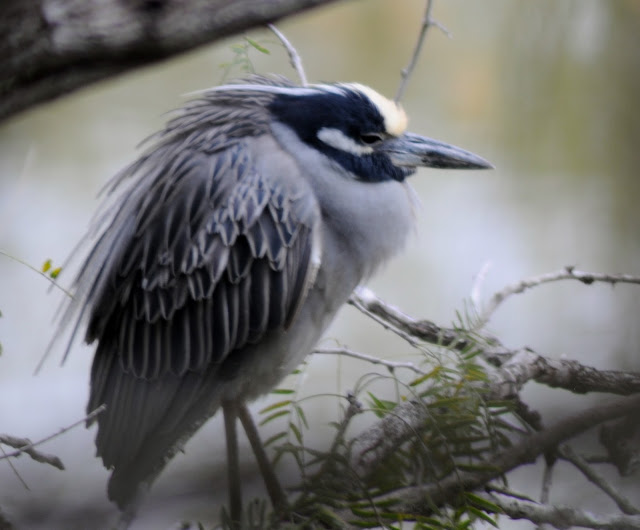A DEAR friend of mine (not mentioning any names) chided me for my lack of blog postings this month. When looking over my daily log, I realized that working has cut into the time we usually spend exploring. We did squeeze in a few adventures, so for Ruthie, I have gathered a few highlights to post.
Met up with Peggy Rudman at one of our favorite Wildlife Refuges, Laguna Atascosa. Peggy is staying in Mission, which is about 50 miles west of where we are located. Juliet Vallejo, a Ranger at Resaca, came along for a pretty good birding day. Peggy's expertise always makes for great birding.
The area around the visitors center was quiet that morning, but this Long-billed thrasher posed nicely while we were in the picnic area. I missed a great shot at a Northern Parula that came to the feeding station.
Like this better than "No Trespassing".
Peggy, Marlin and Juliet spotted lots of ducks and wading birds but the treat for the day was a lazy loop made overhead by the Aplamado Falcon. The Aplamado was extinct from Texas for many years, until a successful restoration project reintroduced them in this area. They are now established here and there are multiple breeding pairs.
(picture from Wikapedia)
The next week we went over to Progreso, Mexico for the first time this year. We met Terry and Ken Smelcer, along with Ken's brother Maynard and wife Nancy at the parking lot on the US side of the border. It costs $.50 to walk across the bridge from the US side into Mexico, but only $.25 to return home.
Lunch at Angel's Restaurant
Ken and Maynard don't look very happy for some reason.
Angel's is on the third floor, accessed via a sketchy elevator. The Restaurant is staffed by all male servers dressed in black pants, white shirts, black vests, and bow ties. Should have had a picture.
After lunch and some shopping, we stopped at a small canteen, called Jessica's, for a drink. Fun Mexican pottery, but too big (and more expensive) to transport over the bridge and home.
Terry and I could not resist the bargain flower pots at the Canada store. For $4.95 we were willing to carry them the 1/2 mile walk.
My favorite sign of the day, appropriately located behind today's clientele!
On Sunday night the Smelcers returned to Brownsville. We found a great restaurant that has a band playing every Sunday night. Cobleheads Restaurant has an open air patio overlooking a Resaca and the blues music was fantastic.
Resaca is the Spanish word for Oxbow lake. Before the Rio Grande River was controlled by several dams, it would usually flood annually. The flooding water would create deep arroyos, or ditches, which would dry up as the river receded and they became cut off from the main River. Some resacas have water most of the time from a natural sources. Most need to be artificiality filled. The Resaca at our park, which requires refilling on a monthly basis, buys its water from the local water district.
Ken and Maynard still don't look happy.
Spring has sprung here in Texas. The Huisache and the Acanua trees are all in bloom
The Huisache tree, pronounced Wisachie, is native to Texas and they occur all over this park. When they are in bloom, the fragrance is everywhere and the blossoms create a yellow carpet when they fall off the trees.
The blossoms are like little puff balls.
The Anacua blooms are white clusters of tiny star shaped flowers
Each of these blooms will become an orange berry that is loved by birds and other wildlife.
Wild flowers are popping up everywhere.
Our most common wildlife sighting. We see these Nine Banded Armadillos throughout the park, digging for grubs wherever there is soft dirt.
This is Rey, resident dog here at Resaca de la Palma. A friendly pup that keeps the wild animals at bay within the maintenance yard.
Marlin has been busy creating some new, natural looking, bird feeders for the feeding stations here at the visitors center.
He carves a troth in Texas Ebony logs, deep enough that it can be filled with bird seed each morning. Then he locates a spot in an existing tree where the feeder log can be secured.
These log feeders are rugged enough to stand up under the weight of our wild turkeys that come for a free meal.































































